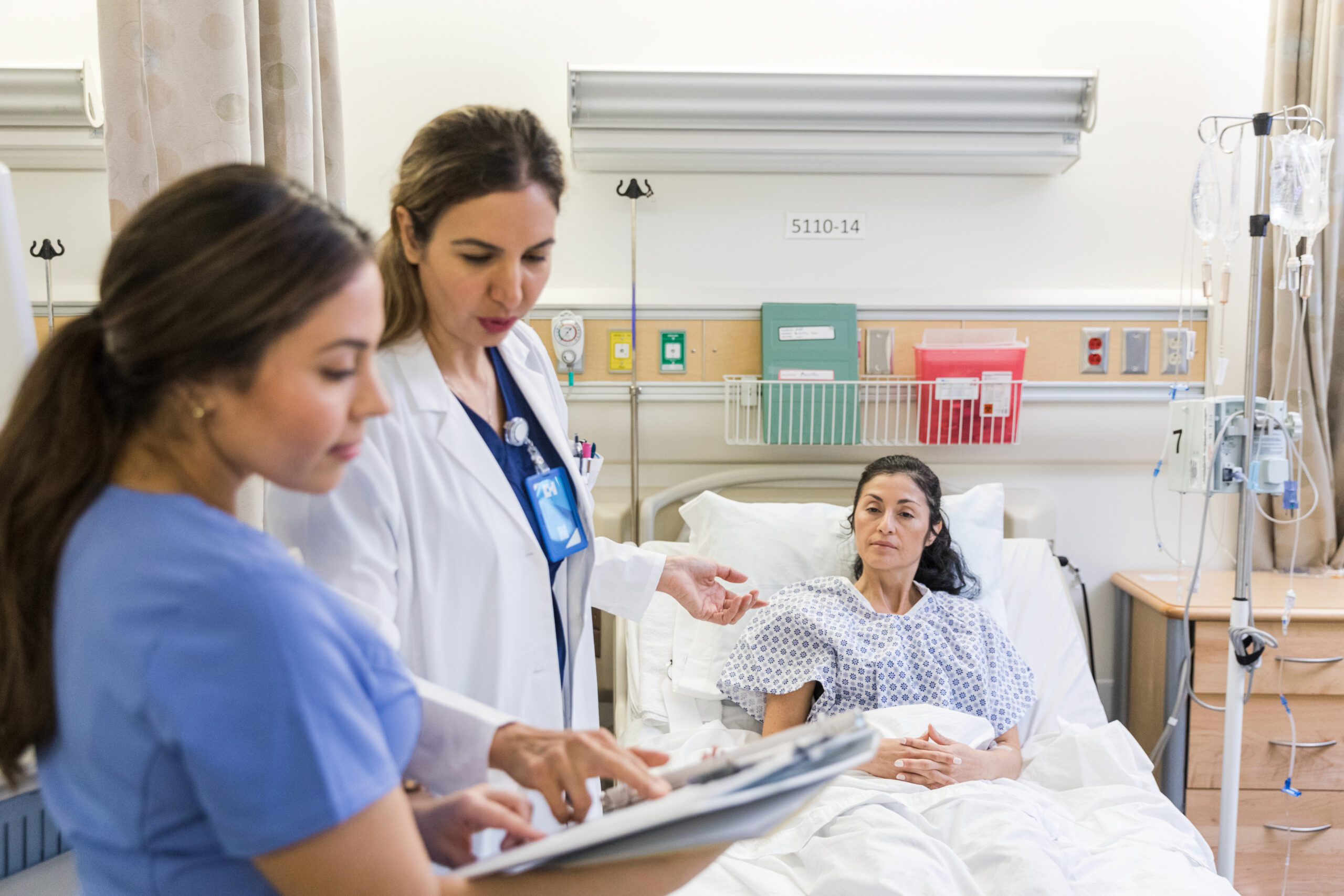Congratulations on reaching clinical rotations, a pivotal stage of your medical education! As a chief resident, I’ve guided many students through their internal medicine rotation, and I know it can feel both exciting and overwhelming.
Internal medicine is a wonderful starting point for your first rotation, as it builds upon the foundation for your clinical skills (physical exam skills, history taking etc.) and teaches you how to think critically about patient care, from differential diagnoses to eventual management of complex cases.
In this guide, I’ll walk you through what to expect on your first internal medicine rotation, how to navigate your responsibilities, and strategies to excel. Let’s begin!

Rotations are the perfect time to start thinking about which medical specialty you’d like to pursue! For a side-by-side comparison of specialties, check out our FREE Medical Specialties Breakdown!
What to Expect on Your Internal Medicine Rotation
Internal medicine is a specialty focused on diagnosing and managing adult patients with a wide range of illnesses. During both your inpatient (in the hospital) and outpatient (in the clinic) months, you can expect to encounter everything from acute ailments such as pneumonia and other infectious diseases to chronic issues such as hypertension and diabetes as well as their associated complications.
Furthermore, you’ll see varying degrees of complexity and severity from multisystem diseases. This rotation is designed to teach you the nuts and bolts of patient care, including history taking, physical exams, forming differential diagnoses, and implementing treatment plans.
Common Themes to Recognize in Internal Medicine
Multisystem Pathologies
Many internal medicine patients have overlapping conditions, requiring you to think holistically. For example, managing diabetes often involves addressing cardiovascular, renal, and neurological complications that stem from having high blood sugar for years.
To succeed, think about the multifactorial effects and understand disease pathologies for different organ systems. Doing so will impress those working with you from residents to attending physicians.
Interdisciplinary Teamwork
Success in internal medicine depends on collaboration with physicians, nurses, social workers, dietitians, and pharmacists. During the rotation, you’ll learn how to contribute effectively to a multidisciplinary team. For example, consider a case involving a hospitalized patient with poorly controlled diabetes and new-onset heart failure.
The interdisciplinary team would approach this case as follows:
- Physicians take the lead in diagnosing the patient and developing an overarching care plan, including optimizing glucose control and managing heart failure symptoms.
- Nurses monitor the patient’s vital signs, assess for fluid overload, and provide education about medication administration and symptom management.
- Dietitians develop a personalized meal plan to manage both diabetes and heart failure, balancing carbohydrate intake with fluid and sodium restrictions.
- Pharmacists review the patient’s medications for interactions, recommend adjustments for renal function, and provide counsel on how to use insulin pens or adjust doses safely.
- Social workers assist with discharge planning, ensuring the patient has access to medications, glucose monitoring supplies, and follow-up appointments.
As with any team, communication is key. Communication on daily interdisciplinary rounds and a shared electronic health record (EHR) allow the team to align their efforts and address emerging challenges collaboratively.
A Day in the Life: Your Typical Internal Medicine Rotation Schedule
Now let’s take a look at what you can expect your day to look like. The following schedule is fairly standard:
6:30-7:00 a.m.: Pre-rounding
Preparation is everything. Arrive early to review patient charts and prepare for rounds. Take note of overnight events, lab results, imaging, changes in vital signs, and anything else of interest for the team.
Write a brief outline of each patient’s progress and key issues to address during rounds. Review any pending studies or consult notes and recommendations.
7:00-9:00 a.m.: Morning Rounds
You’ll present your assigned patients to the team, which typically includes an attending, senior resident, intern, and potentially other students.
Most presentations are done in the SOAP format. SOAP stands for:
Subjective: These are overnight complaints or updates directly from the patient.
Objective: Vital signs consist of physical exam findings, labs, and imaging findings.
Assessment: This is a brief summary of the patient’s status.
Plan: Your proposed management, such as “Continue IV antibiotics for his infection and monitor WBCs. Plan discharge for tomorrow if no fevers or further overnight events occur.”
9:00 AM-12:00 p.m.: Patient Care and Procedures
This is when you’ll carry out tasks assigned during rounds. You’ll be expected to:
- Order labs or imaging.
- Follow up with consulting teams and make new consultations as needed.
- Communicate updates to patients and families.
You may also have opportunities to assist with or perform basic procedures like venipunctures, arterial blood gases, pericentesis, etc. under supervision.
12:00-1:00 p.m.: Noon Conference + Lunch
Join a dedicated educational session held during lunchtime, often covering core clinical topics, case discussions, or updates in medical knowledge. Noon conference is meant to enhance learning in a more informal setting while residents take a break from clinical duties.
For medical students, the role at noon conferences typically involves engaging with the material, asking questions, and contributing to discussions. Occasionally, students may present a brief case or topic under guidance, showcasing their clinical reasoning and knowledge.
1:00-3:00 p.m.: Follow-up Patient Care
- Review updated labs, imaging, or consultant recommendations.
- Reassess patients who aren’t responding to treatment as expected.
- Document any significant changes in the patient’s chart.
- Work on discharge orders and notes for patients who are well and on their way out of the ward.
3:00-5:00 p.m.: Admissions and Teaching
New admissions often arrive in the afternoon (this may differ depending on how your hospital service handles admissions).
Medical students may be asked to:
- Perform a thorough history and physical exam on newly admitted patients.
- Present the case to the resident or attending, focusing on key findings and your initial differential diagnosis.
- Start with basic orders and notes as you wrap up for the day team and let the night team take over.
5:00-6:00 p.m.: Sign Out and Wrap Up
All that’s left now is to attend the sign out, where patient care responsibilities are handed off to the night team.
Use this time to ask residents for feedback or clarify any lingering questions. Reflect on the day. Ask yourself, what went well? What could you improve tomorrow, based on feedback from your team?
Your Responsibilities as a Medical Student on Clinical Rotation
*Disclaimer: The responsibilities and roles of medical students during clinical rotations vary between medical schools and clinical training sites. The expectations outlined here are general and may not reflect the specific policies or requirements of your institution. Students should always refer to their school’s guidelines and communicate with their clinical supervisors to clarify their roles and responsibilities. What follows is based on my experience and the AAMC requirements.
As a medical student, your role is to learn while also contributing meaningfully to patient care. Here’s what’s expected of you during your clinical rotations:
1. Patient Presentations
Your goal here is to deliver concise, well-organized presentations with relevant patient information, as well as a thought-out assessment and plan:
- Practice your SOAP format.
- Avoid extraneous details—focus on what’s clinically relevant.
- Be prepared to answer follow-up questions about your patient’s condition.
2. Progress Notes
Your progress notes should reflect the same structure as your presentation. Include clear and actionable plans as well as consultation recommendations. Take ownership of your notes—they’ll often serve as the basis for team discussions.
3. Active Participation in Rounds
Be engaged. Listen attentively, ask thoughtful questions, and take detailed notes during rounds. Volunteer to take on tasks, such as calling consultants, or updating patients and families.
4. Self-Directed Learning
Use your cases to guide your studying. For example, if you encounter a patient with heart failure, review its pathophysiology, diagnostic criteria, and treatment guidelines that evening in order to be well-versed in your presentation the following day.
5. Teamwork
Offer to help your colleagues whenever possible—teamwork is essential in medicine. Respect everyone’s contributions, from the attending to the unit secretary.
It’s also important to communicate clearly and respectfully as part of your medical team. If you’re unsure about a task, ask for clarification. It’s better to ask than to make a mistake.
Keep the team updated on any developments, like a critical lab result. Show initiative and anticipate the next steps. If a patient’s potassium level is low, suggest rechecking it after replacement therapy. Look for learning opportunities, such as assisting with procedures or taking on complex cases.
General Tips for Excelling During Your Internal Medicine Rotation
Now let’s look at some broader suggestions that’ll help you succeed on your internal medicine rotation.
I recommend the following:
1. Prepare before you start.
Review common inpatient conditions such as diabetes, pneumonia, heart failure, sepsis, and COPD.
Familiarize yourself with key medications and their side effects.
2. Stay organized.
Keep a notebook or app to track patient updates, pending labs, and tasks for the day.
Use checklists to ensure nothing slips through the cracks.
3. Practice presentations.
Rehearse your patient presentations with peers or residents. Ask for feedback on your clarity and flow.
4. Seek and apply feedback.
Actively seek constructive criticism. Be specific. For example, instead of asking a general question such as “What can I improve in my presentations?” it may be more helpful to ask, “How can I improve the assessment and plan portions of my SOAP presentation?” Then implement the feedback you received to show growth and commitment.
5. Understand how this will help you going forward.
Your internal medicine rotation will prepare you for other rotations. That’s the beauty of this, as the skills you develop—like teamwork, patient communication, and clinical reasoning—are applicable across specialties.
Final Thoughts
Your first clinical rotation is a monumental step in your journey to becoming a physician. Starting with internal medicine is an exciting yet sometimes overwhelming experience, but it’s also where you begin to bridge the gap between the classroom and patient care.
Approach each day with curiosity, humility, and a willingness to learn. Take every opportunity to ask questions, observe, and reflect on what you see and do. Remember, mistakes are not failures but opportunities to grow, and every patient encounter is a chance to improve your skills and understanding.
Your internal medicine rotation, in particular, will challenge you to think critically, synthesize information, and make decisions that impact patient outcomes. It’ll push you to work collaboratively with interdisciplinary teams, communicate effectively, and continually refine your bedside manner.
The skills and habits you develop here will form the foundation of your future practice, regardless of the specialty you choose. And who knows? With the right mindset, preparation, and determination, you might even go on to pursue IM upon graduation!
(One final note: don’t forget to care for yourself during this intense period. Prioritize sleep, maintain a support network, and remember to seek help when needed.)

Good luck on your first rotation! And when it comes time to take your first shelf exam, check out our FREE quiz to make sure you’re on track 😎





